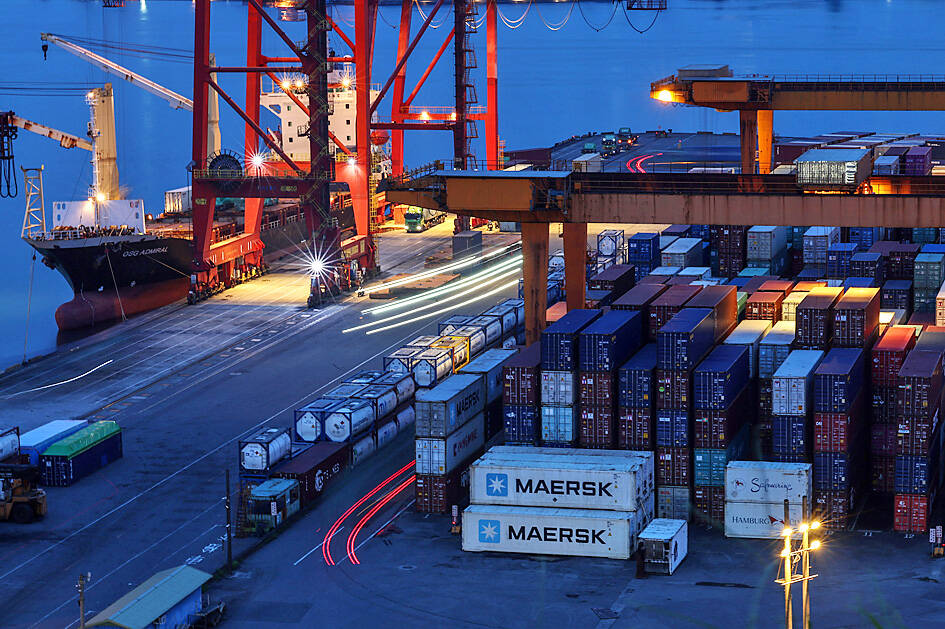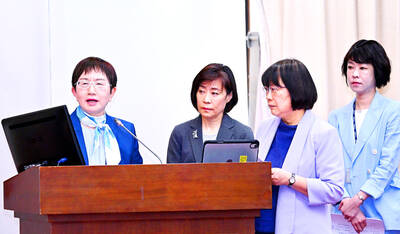Taiwan’s exports are expected to slow to a crawl through the end of the year, Minister of Finance Su Jain-rong (蘇建榮) said in an interview yesterday, as waning global demand piles pressure on the economy.
Growth in overseas shipments might slump to single digits this quarter, Su said in Manila.
He cited global headwinds including the US Federal Reserve’s rate hikes, and slowdowns in the US and Europe, which are major trading partners for Taiwan.

Photo: CNA
Taiwan had been enjoying nearly a year and a half of double-digit export growth during the COVID-19 pandemic, with a global computer chip shortage fueling demand for its electronics and semiconductors.
Last year the economy grew at the fastest pace since rebounding in 2010 from the global financial crisis of the prior few years.
However, this year, Taiwan has faced several challenges.
Global demand for many products has waned as inflation elsewhere skyrockets and several major economies face the prospect of a slowdown or recession.
China, another important trading partner, has struggled with ongoing COVID-19 outbreaks and lockdowns, along with a property crisis.
August export growth in Taiwan slowed to just 2 percent, the slowest pace in more than two years, prompting Department of Statistics Director-General Beatrice Tsai (蔡美娜) to warn at the time that “winter is coming” earlier than expected.
Tsai also warned that export data for last month might shrink by as much as 3 percent from a year earlier.
Export orders have also slowed.
While orders gained 2 percent in August, reversing a decline in July, purchases from China and Hong Kong fell more than 25 percent last month.
Almost 40 percent of Taiwan’s exports went to Hong Kong and China for the first eight months of the year, ministry data showed.
Taiwan is watching China’s economic progress carefully, Su said.
Sporadic lockdowns there have dented demand and confidence, becoming a major drag on growth in the world’s second-largest economy.
“We should be careful” if something happens to China’s economy, Su said, adding that Taiwan is trying to mitigate risks stemming from China by diversifying.

‘SWASTICAR’: Tesla CEO Elon Musk’s close association with Donald Trump has prompted opponents to brand him a ‘Nazi’ and resulted in a dramatic drop in sales Demonstrators descended on Tesla Inc dealerships across the US, and in Europe and Canada on Saturday to protest company chief Elon Musk, who has amassed extraordinary power as a top adviser to US President Donald Trump. Waving signs with messages such as “Musk is stealing our money” and “Reclaim our country,” the protests largely took place peacefully following fiery episodes of vandalism on Tesla vehicles, dealerships and other facilities in recent weeks that US officials have denounced as terrorism. Hundreds rallied on Saturday outside the Tesla dealership in Manhattan. Some blasted Musk, the world’s richest man, while others demanded the shuttering of his

ADVERSARIES: The new list includes 11 entities in China and one in Taiwan, which is a local branch of Chinese cloud computing firm Inspur Group The US added dozens of entities to a trade blacklist on Tuesday, the US Department of Commerce said, in part to disrupt Beijing’s artificial intelligence (AI) and advanced computing capabilities. The action affects 80 entities from countries including China, the United Arab Emirates and Iran, with the commerce department citing their “activities contrary to US national security and foreign policy.” Those added to the “entity list” are restricted from obtaining US items and technologies without government authorization. “We will not allow adversaries to exploit American technology to bolster their own militaries and threaten American lives,” US Secretary of Commerce Howard Lutnick said. The entities

Minister of Finance Chuang Tsui-yun (莊翠雲) yesterday told lawmakers that she “would not speculate,” but a “response plan” has been prepared in case Taiwan is targeted by US President Donald Trump’s reciprocal tariffs, which are to be announced on Wednesday next week. The Trump administration, including US Secretary of the Treasury Scott Bessent, has said that much of the proposed reciprocal tariffs would focus on the 15 countries that have the highest trade surpluses with the US. Bessent has referred to those countries as the “dirty 15,” but has not named them. Last year, Taiwan’s US$73.9 billion trade surplus with the US

Prices of gasoline and diesel products at domestic gas stations are to fall NT$0.2 and NT$0.1 per liter respectively this week, even though international crude oil prices rose last week, CPC Corp, Taiwan (台灣中油) and Formosa Petrochemical Corp (台塑石化) said yesterday. International crude oil prices continued rising last week, as the US Energy Information Administration reported a larger-than-expected drop in US commercial crude oil inventories, CPC said in a statement. Based on the company’s floating oil price formula, the cost of crude oil rose 2.38 percent last week from a week earlier, it said. News that US President Donald Trump plans a “secondary